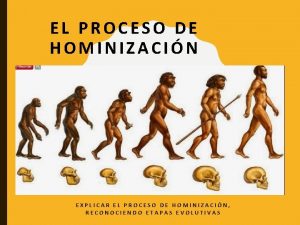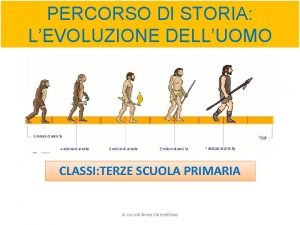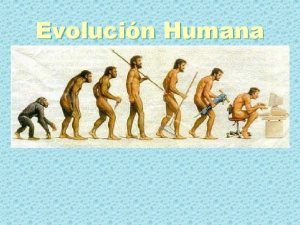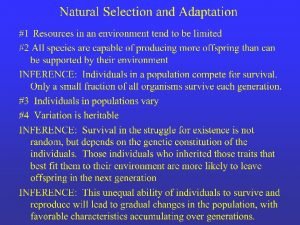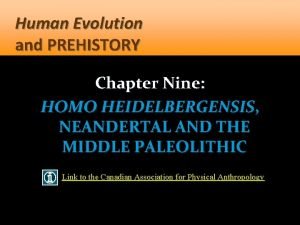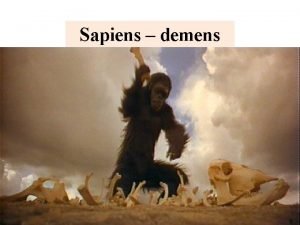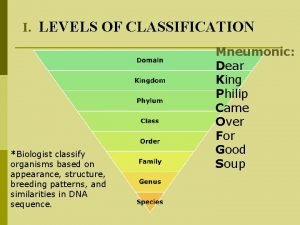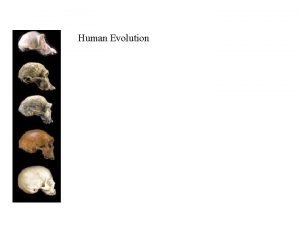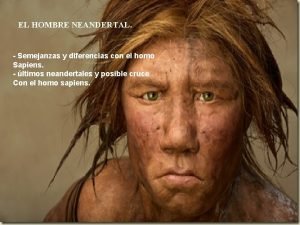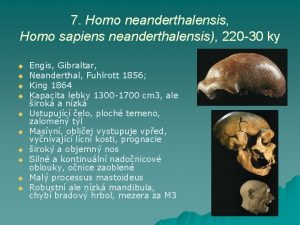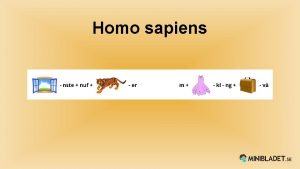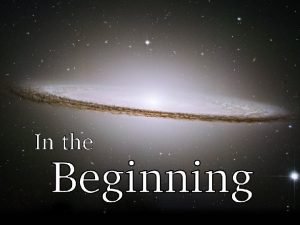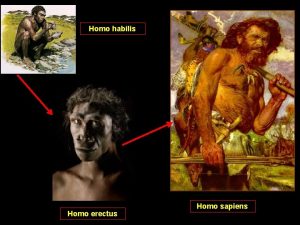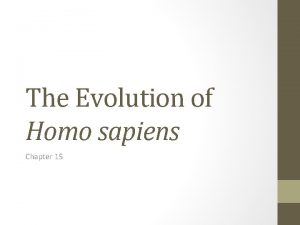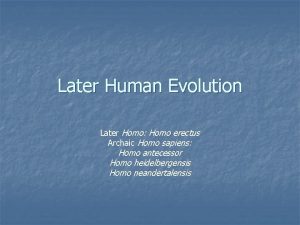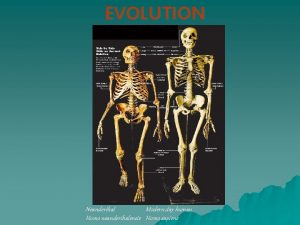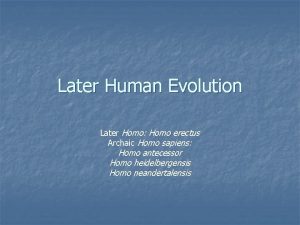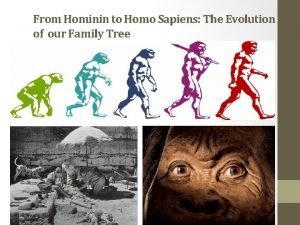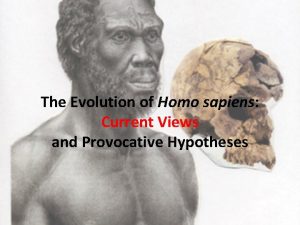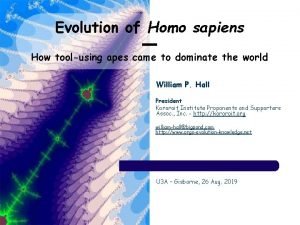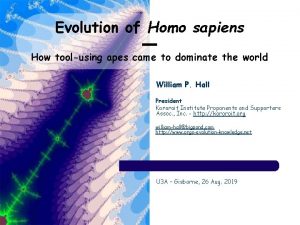Human Evolution The rise of Homo sapiens Where
































- Slides: 32

Human Evolution – The rise of Homo sapiens

Where to Begin? Right Now! The genetic analysis shown indicates that human ancestors migrated out of Africa three times in the last 1. 7 million years.


We’ve Got Fossils

There’s LOTS of Extinct Primates that Came Before Us! This isn’t even a complete diagram! There are several identified fossil species missing – and there’s still over a dozen ancient hominids shown!

Modern Homo Species: from 1. 7 MYA to today • Genus of “modern” humans includes • H. sapiens, • H. neanderthalensis (neanderthals) • And several others, including…

Homo erectus • H. erectus is the species of Homo that originated in Africa and went on to populate the rest of the world, using fire and stone technology. We are their direct descendents.


“Archaic” Homo Species: • Includes some australopithicus species, Homo habilis, and others. ~2. 8 to 1. 7 MYA • All were located exclusively in Africa

The “Erects” – Our ancient ancestors on 2 legs. From ~ 5 MYA to ~2. 8 MYA • This is where arguments really get going as to who our “direct” ancestor species was. • “Lucy” (3 MYA) is among these ancient homonids.

The Split with other Primate Lines Between 5 and 7 MYA • Somewhere in Africa there was a single population of primate that gave rise to all of the species we just spoke of. • This population was definetly a “gracile” ape. • Little is known about the very earliest human ancestors because, as you might expect…

6 -7 Million year old primate bones are all from Apes!

Just Remember – There’s Lots of Hominids in Earth’s History Homo sapiens are just the newest design of a 2 -legged primate model that arose millions of years ago. It’s our brains that set us apart from all of the rest.

Perspective: 10, 000 years = years 4 10 • Imagine all of the time that has passed since the most ancient civilizations beginning in Egypt and Mesopotamia • Every civilization there ever was… every king, every queen, every nation or people… all arose in this time

Multiply by 6 = 60, 000 Years • 60, 000 years ago is the “great leap” to complex social organization, as indicated by early art and ceremony

Multiply BY 100! • Think of every generation of people that has come and gone since our ancestors first figured out how to draw a picture on a wall. • No try to imagine that all happening 100 times… • That’s 6, 000 years – when we split from the ape line.

30, 000 generations • That’s what separates us from our common ancestor with chimpanzees. • Even if every generation was only a day long, that would still be over 80 years!!!

30, 000 generations = 2 years in prokaryotes • Prokaryotes are the easiest way to study evolution because some of them reproduce every 30 minutes… • A prokaryote population can evolve as much (or more) in 2 years than humans have in 6, 000.


Which of these looks most like your Homo sapiens skeleton? Human

The Primate Family Tree Colugo: most similar to primate without being a primate.

“Ida” Darwinius massilae: 47 MYA • Not a human ancestor. • Oldest known primate fossil. • Gives clues as to what the first primate ancestors might have been like.

Mammals • Mammal species over 65, 000 years old are all similar in structure to small rats, mice, or shrews of today Tree Shrew: Living organism most similar to the extinct common ancestor of all primates

Animals Evolve: ~600 MYA • Between 550 and 140 MYA, all of the common plant and animal phyla around today evolved.

Eukaryote evolution: Plants, Animals, and Microbes, oh my! Fungi Animals Amoebas Unicellular groups Plants Unicellular groups

The First common Ancestors of all Life: Archaea (prokaryotes)

3. 7 Billion years ago – the first cells • This is where biology begins. Before this, it’s all geology / astronomy / physics…

Birth of the Universe: The Big Bang • What: Quantum singularity spontaneously transforms into pure energy. • When: 13. 7 x 109 years ago (BYA) • Why it’s Important: Everything, including all space, time, matter, and energy in the Universe begins.

Formation of the Milky Way • What: This is what our galaxy looks like when viewed from Earth, looking towards its center. There about 2 x 1011 stars in it. • There are billions of other galaxies in the Universe.

Milky Way from Above • What: This is what our galaxy probably looks like when viewed from above. • When: The oldest stars in the galaxy are about 13. 2 x 109 years old.

The Solar System and Sun • What: A protoplanetary disk that will become the Sun and planets condenses due to gravity in a molecular cloud of gas and dust. • When: About 4. 6 x 109 years ago.

Formation of Earth and Moon • What: Massive collision produces the moon from the cooling proto-Earth • When: About 4. 5 x 109 years ago.
 Etapas de la hominización
Etapas de la hominización Verifica ominidi terza elementare
Verifica ominidi terza elementare Carte homo sapiens
Carte homo sapiens Homo sapiens
Homo sapiens Homo sapiens neanderthalensis
Homo sapiens neanderthalensis Arbol filogenetico hominidos
Arbol filogenetico hominidos He was treated like a ____ and cast out from his community.
He was treated like a ____ and cast out from his community. Sound spelling and symbols
Sound spelling and symbols Homo sapiens taksonomi
Homo sapiens taksonomi Sebutkan tiga ras pokok homo sapiens ! *
Sebutkan tiga ras pokok homo sapiens ! * Homo habilis
Homo habilis Homo sapiens
Homo sapiens Whats homo sapiens
Whats homo sapiens Caracteristicas fisicas de homo sapiens
Caracteristicas fisicas de homo sapiens Caracteristicas fisicas de homo sapiens
Caracteristicas fisicas de homo sapiens O que é homo sapiens
O que é homo sapiens O que é homo sapiens
O que é homo sapiens Homo sapiens kingdom
Homo sapiens kingdom King philip classification
King philip classification Homo sapiens idaltu
Homo sapiens idaltu Diferencia entre homo sapiens y neandertal
Diferencia entre homo sapiens y neandertal Saccopastore
Saccopastore Rise and rise again until lambs become lions
Rise and rise again until lambs become lions Tricky dick
Tricky dick Raise and rise again until lambs become lions
Raise and rise again until lambs become lions Rise and rise again until lambs become lions origin
Rise and rise again until lambs become lions origin Virgo weebly geschiedenis
Virgo weebly geschiedenis Weebly geschiedenis virgo sapiens
Weebly geschiedenis virgo sapiens Ecotest dosimeter portable
Ecotest dosimeter portable Liepi
Liepi Phono sapiens meaning
Phono sapiens meaning Huizinga play
Huizinga play Sapiens nihil affirmat quod non probet
Sapiens nihil affirmat quod non probet
